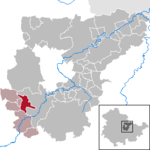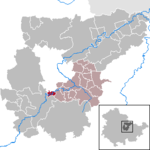Bad Berka (German: [baːt ˈbɛʁka] ) is a German spa town, situated in the south of Weimar region in the state of Thuringia. With its almost 8,000 inhabitants Bad Berka is the second biggest city in Weimarer Land district (after Apolda, 23,000). The river flowing through the town, which is embedded in new red sandstone, is called Ilm. Since 1 December 2008, the city has incorporated the former municipality of Gutendorf.
Bad Berka is a spa town with an iron-rich spring and Kneipp facilities. In 2002 the award of "State Recognised Spa with Mineral Spring Health Facility" was given to the city.
In order to treat tuberculosis, a clinic was erected in 1952. This was the beginning of the main economic sector of the city. Bad Berka's Zentralklinik has since gained a reputation as a center of medicinal expertise far beyond the boundaries of Germany. Its foundation can be traced back to 1898.
In addition, there was a rehabilitation clinic built after the fall of the Berlin Wall. The "Median-Klinik" consists of two buildings, which were opened in 1994 and 1997.
Because of its proximity to the cultural capital Weimar and association with numerous historical figures, Bad Berka is also popular among tourists. Between 1812 and 1828 Goethe visited his friend Heinrich Friedrich Schütz several times. He was also involved in the plans of the spa. Therefore, Bad Barka is called "Das Goethebad im Grünen" (Goethe spa in greenery), as well. Bad Berka is surrounded by spruce and beech forest.
Other bigger cities in the vicinity are Jena (20 km (12 mi) north-east), Erfurt (20 km (12 mi) north-west) and Weimar (12 km (7 mi) north).








